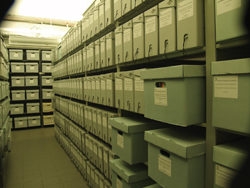|
|
Vol.
35 No. 1
January-February 2013
by Patrick H. Shea
For nearly a century, IUPAC has served to advance the chemical sciences worldwide, and to contribute to the application of chemistry in the service of Humankind. Adding to that mission, the Chemical Heritage Foundation (CHF) in Philadelphia strives to show the ways in which this service to chemistry has touched all of our lives, and frequently in unexpected ways. With its first-rate collection of artifacts, archives, fine-art, and rare books, CHF traces scientific progress and demonstrates how chemistry has created and continues to shape our modern world.
 |
Many years ago, CHF created an archival program to actively collect and preserve the papers of organizations and individuals whose work has significantly advanced our scientific understanding. Through this material we document the history and heritage of the chemical and molecular sciences and illuminate the broad impact of these sciences on society in the twentieth century. The professional papers of scientific organizations often prove to be the most valuable sources for recording the history of science and constitute the primary material record of the human endeavor to investigate and shape nature.
In the early years of CHF, IUPAC records were identified as a critical record set in need of permanent archival preservation. To date we have collected over 200 linear feet of IUPAC records spanning from its inception in 1919 through 1995. The broad range of IUPAC activities has attracted scholars from around the world to use this collection. Indeed, it is perhaps one of the most highly used collections in the entire CHF archive, as researchers explore topics such as scientific nomenclature, environmental science, and scientific education, as well as topics related to the interdisciplinary role of chemistry as the central science.
To keep this important archive active and relevant to contemporary scholars it is important we now take steps to fill in the missing records from IUPAC’s last 17 years. Indeed, the heart of any organization’s memory is in its records, such as original letters, minutes, reports, photographs, publications, and other documents that officers, members, or volunteers have produced and compiled over the years. These documents provide unique testimony to the achievements of an organization, and such materials are also extremely valuable for administrative, legal, fiscal, and public relations purposes.
As a dedicated archival repository, CHF is a place where professional archivists and curators preserve and provide access to historically significant documents. We provide environmentally secure storage, while safeguarding the long-term integrity of archival material by monitoring its handling and use.
Many, but not all, of the records produced by IUPAC have long-term historic value. CHF is most interested in the records that best illustrate the purpose, activities, and policies of IUPAC. Such documents usually represent an “end product”—a final report, for example, instead of a draft. CHF accepts donations of as little as a single item and as large as dozens of boxes. Material need not be organized, it need not be “old,” and it need not relate to a famous individual, event, or organization in order for it to be historically significant. Generally, however, repositories are more interested in a coherent body of material rather than individual items. It is also important to only donate records that are inactive and no longer regularly used for routine business.
I encourage all of the members and volunteers of IUPAC to ponder the subject of archiving their own records related to IUPAC with CHF, lest duty to posterity be neglected in the sheer rush of current pressures.
As not all records are suitable for archival preservation, it is important to discuss these issues with a CHF archivist prior to transferring any records to CHF. Typically, before any records are transferred, an archivist will survey the papers to determine which materials have enduring historical value. Because the research value of records may be diminished if items are removed or rearranged, records should not be weeded, discarded, or rearranged before they are examined by an archivist.
If you or someone you know has records that may be suitable for archival preservation at the Chemical Heritage Foundation, please contact Patrick H. Shea, CA, Senior Archivist, Chemical Heritage Foundation, 315 Chestnut Street, Philadelphia, PA 19106 <[email protected]>.
www.chemheritage.org
Page
last modified 3 January 2013.
Copyright © 2003-2013 International Union of Pure and Applied Chemistry.
Questions regarding the website, please contact [email protected] |